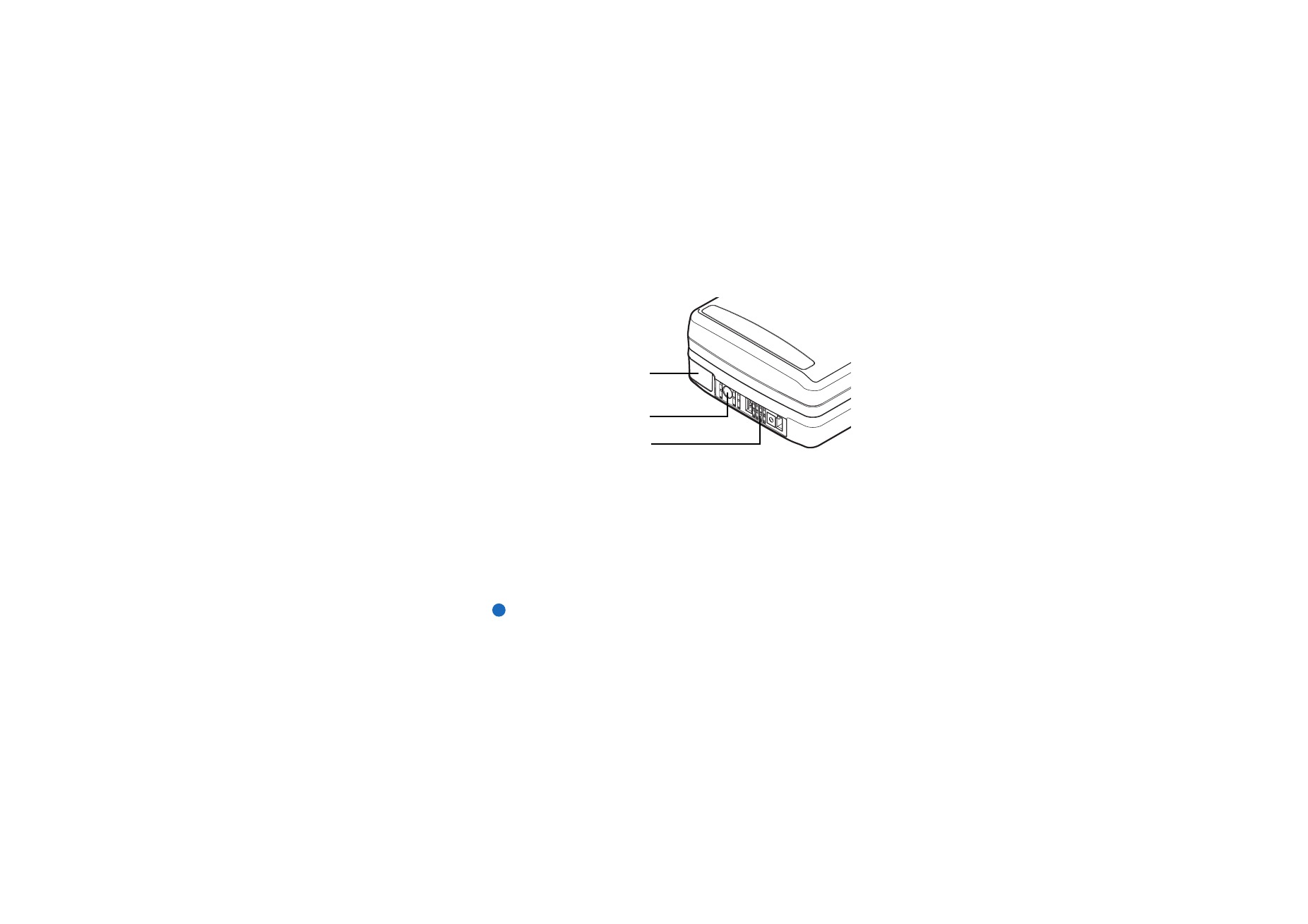
To charge the battery
Note: See important safety information on battery usage on page 22.
for infrared
connection
for the charger
for the RS232
Adapter cable
DLR-
2L
and also the
headset HDC-8L

©2001 Nokia Mobile Phones. All rights reserved.
21
G
enera
l informa
tion
Tip: To check the current
battery level, see the battery
indicator
on the
communicator or phone
display.
1 Connect the charger cable to the bottom of the communicator, as shown in
Figure 8.
Figure 8
2 Connect the charger to the proper voltage AC wall outlet. While charging is in
progress, the battery level indicator scrolls on the phone display.
3 When the battery is fully charged, the bars stop scrolling and four bars are
displayed. You may now remove the charger plug from the communicator.
Note: You can use all the features of the communicator during charging.
When the battery level is low and only a few minutes of operation time remain, a
warning tone will sound, and the message BATTERY IS LOW will be repeated at
regular intervals on the phone display. When the charge level becomes too low for
operation, the RECHARGE BATTERY message will be displayed, accompanied by a
warning tone. If you do not connect the communicator to a charger, the
communicator switches itself off.

©2001 Nokia Mobile Phones. All rights reserved.
22
G
enera
l informa
tion
Note: When you connect a communicator with a fully discharged battery to a
charger, it will take 30-60 seconds before the CHARGING message
appears on the display and the battery indicator bar starts scrolling. After
that, it may take 10-30 seconds before you can switch the phone on.
Battery information
Tip: Read this section for
information on how to
prolong the life of your
battery.
Use the battery only for its intended purpose.
Never use any charger or battery that is damaged or worn out.
Do not short-circuit the battery. Accidental short-circuiting can occur when a
metallic object (for example coin, clip, or pencil) causes direct connection of the +
and - terminals of the battery (metal strips on the bottom of the battery), for
example, when you carry a spare battery in your pocket or purse. Short-circuiting
the terminals may damage the battery or the connecting object.
Leaving the battery in hot or cold conditions, such as in a closed car in summer or
winter conditions, will reduce the capacity and lifetime of the battery. Always try
to keep the battery between +15°C (+59°F) and +25°C (+77°F). A communicator
with a hot or cold battery may temporarily not work, even when the battery is fully
charged. The performance of Lithium-ion batteries is particularly limited in
temperatures below 0°C (+32°F).
Do not dispose of batteries in a fire!
Batteries must be recycled or disposed of properly. Batteries must not be disposed
of in municipal waste.
Note that a new battery’s full performance is achieved only after two or three
complete charge and discharge cycles.

©2001 Nokia Mobile Phones. All rights reserved.
23
G
enera
l informa
tion
Use only batteries approved by the communicator manufacturer and recharge the
battery only with the chargers approved by the manufacturer. With approved
chargers and accessories, the battery can be charged continuously.
The battery need not be fully discharged before recharging. When a charger is not
in use, disconnect it from the power source. Do not leave the battery connected to
a charger for longer than a week, since excessive charging may shorten its life. If
left unused, a fully charged battery will discharge itself over time.
The battery can be charged and discharged hundreds of times, but it will eventually
wear out. When the operating time (talk-time and stand-by time) is noticeably
shorter than normal, it is time to buy a new battery.
Temperature extremes will affect the ability of your battery to charge: allow it to
cool down or warm up first.
Battery operation time is affected by the following: whether both the phone and
the communicator interface are on, radio signal strength, various phone settings,
and the length of the screen blanker period.
It is recommended always to keep a charged battery in the communicator. Keeping
the battery charged maximises the lifetime of the backup battery supplying power
to the real-time clock of the communicator. In case the backup battery is drained,
it will be automatically charged the next time a charged battery is reconnected to
the communicator.
Always close the device cover before removing the battery. Closing the cover will
save all data.

©2001 Nokia Mobile Phones. All rights reserved.
24
G
enera
l informa
tion
Note: The battery does not fit into place if the SIM card is not correctly
installed. Do not force the battery into place! Check that you have
inserted the SIM card as described in the Getting started guide. If the
SIM card is incorrectly installed, remove it by pulling it out of the slot,
and insert it again.